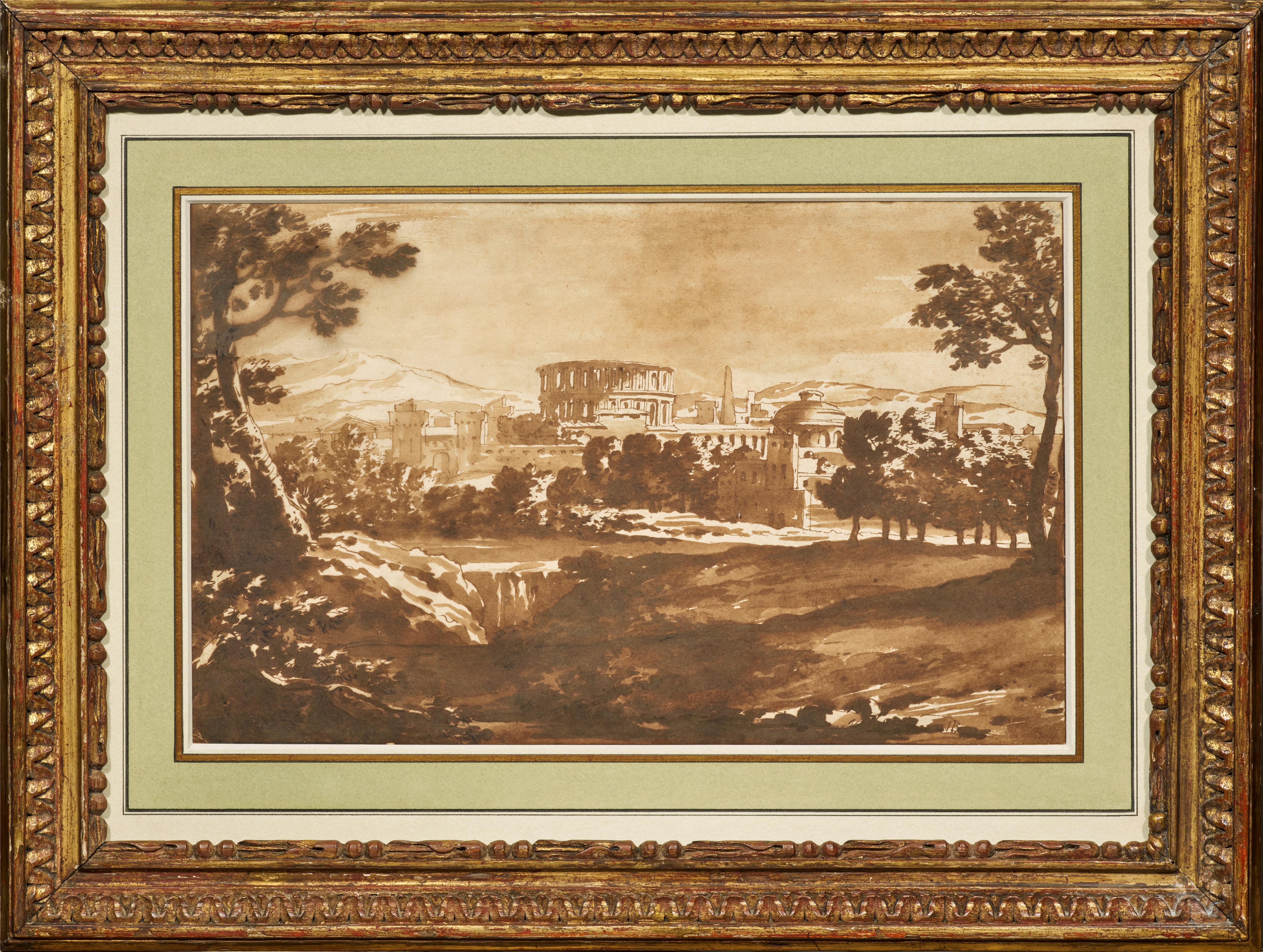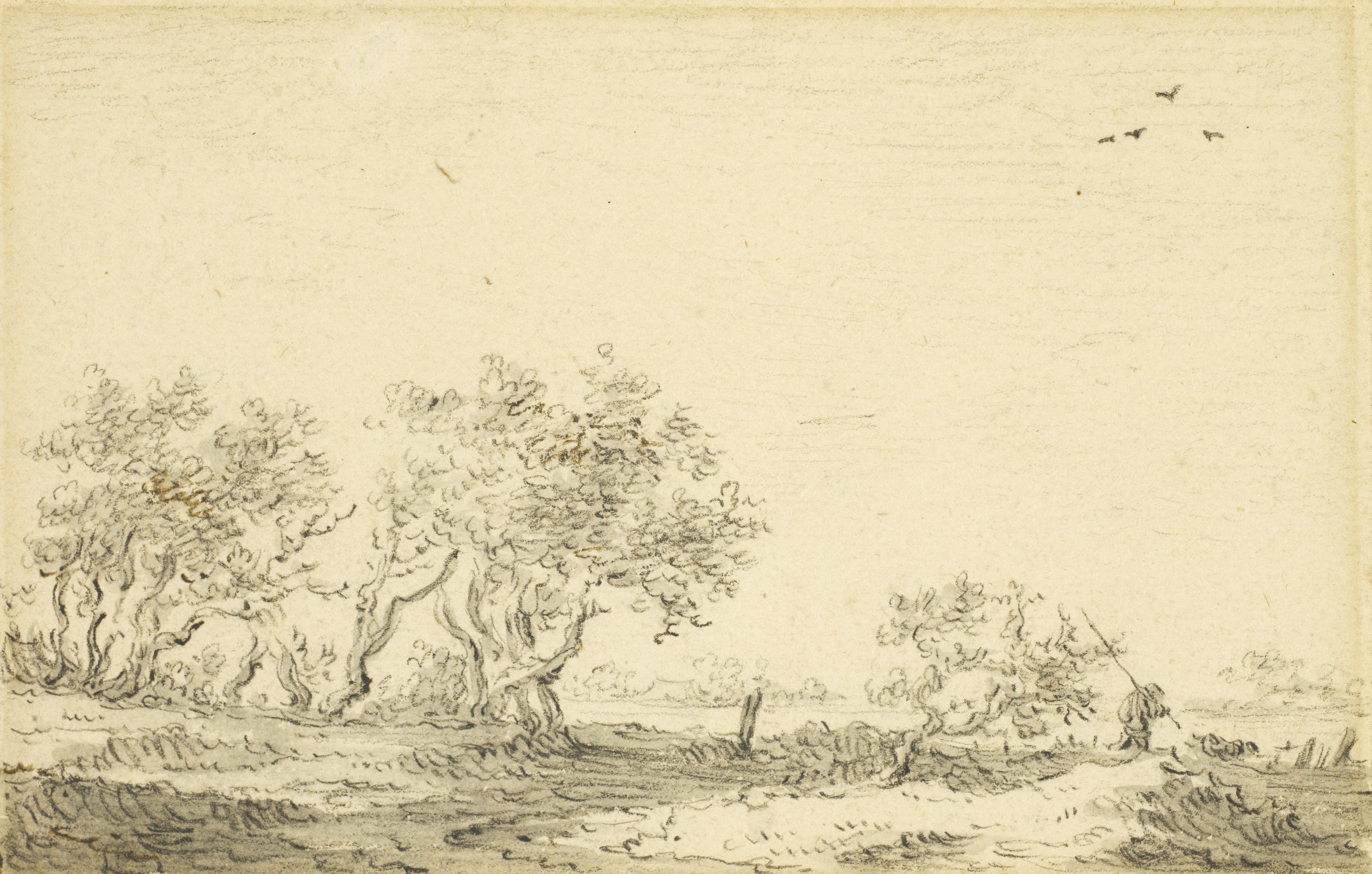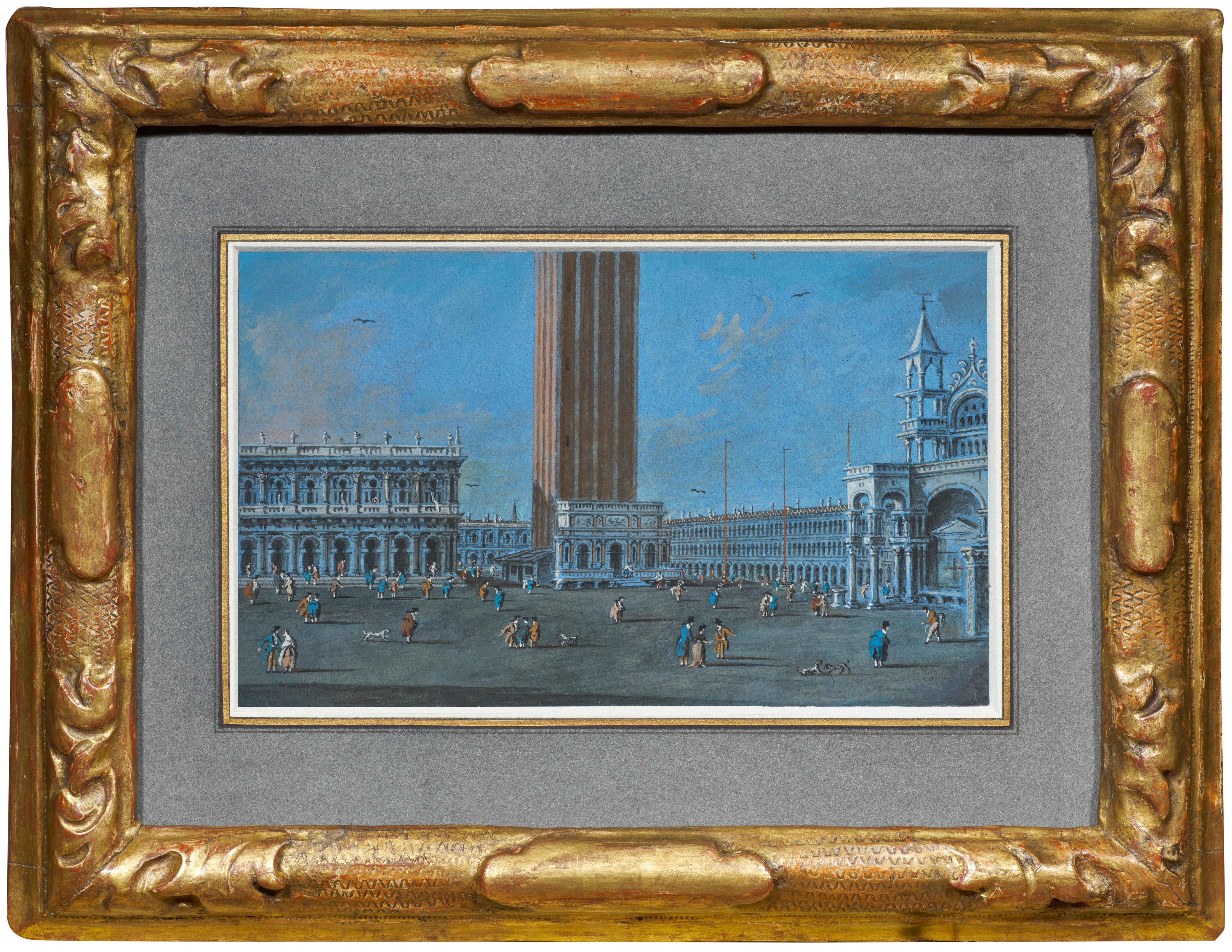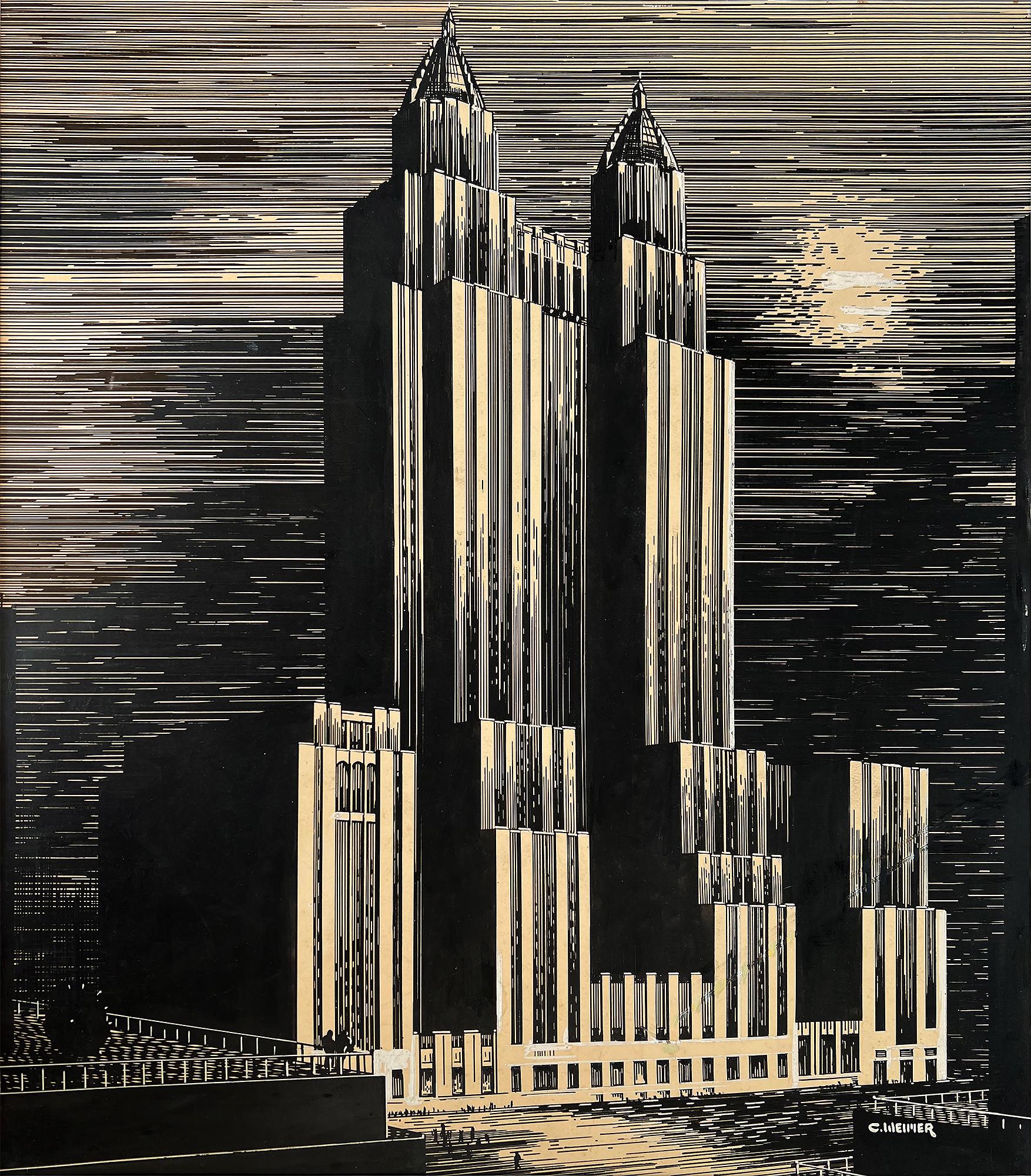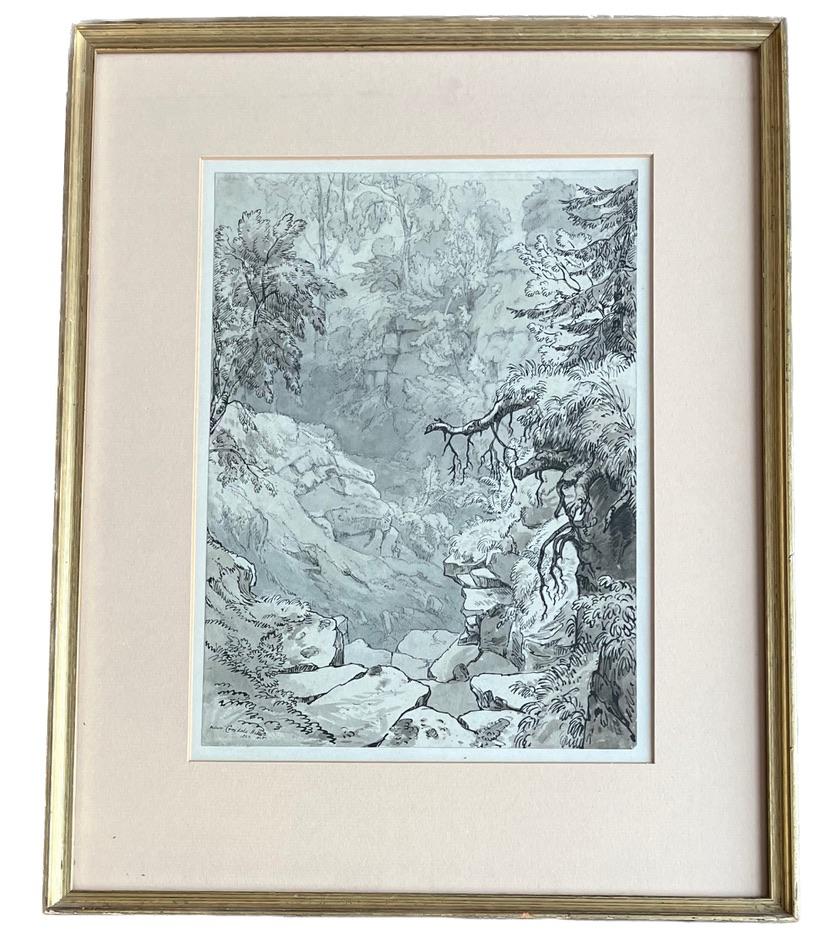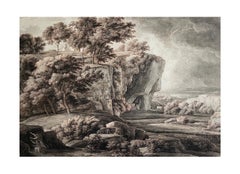
18th Century Classical Old Master Roman Landscape Drawing with Figures
View Similar Items
1 of 13
Abraham-Louis-Rodolphe Ducros18th Century Classical Old Master Roman Landscape Drawing with Figures1770 -1790
1770 -1790
About the Item
- Creator:Abraham-Louis-Rodolphe Ducros (1748 - 1810)
- Creation Year:1770 -1790
- Dimensions:Height: 23 in (58.42 cm)Width: 28 in (71.12 cm)Depth: 3 in (7.62 cm)
- Medium:
- Movement & Style:
- Period:1770-1779
- Condition:
- Gallery Location:London/Yorkshire, GB
- Reference Number:1stDibs: LU58937019102
You May Also Like
- View of an Antique City, a wash landscape by Jan de Bisschop (1628 - 1671)Located in PARIS, FRThe attribution to Jan de Bisschop has been confirmed by the RKD with the following comment: "We base this attribution on the dark washes, the subject represented and the monogram". ...Category
17th Century Old Masters Landscape Drawings and Watercolors
MaterialsInk, Pen
- A landscape drawing by Claude Lorrain, with a preliminary sketch on the versoBy Claude LorrainLocated in PARIS, FRThis study presents a typical Roman countryside landscape: an ancient mausoleum in front of which a cart is passing by followed by two peasants. If the technique (a pen drawing on graphite lines, completed with a wash of brown and grey inks) and the signature inevitably evoke the art of Lorrain, we find on the verso of this drawing additional evidences that lead us to consider this unpublished drawing as a work by the master. The motif of the mausoleum has been taken up in pen on the verso in a technique that can be found in several other drawings by Lorrain. There is also a study of three characters, which can be considered as preparatory to Lorrain’s painting entitled The Port of Ostia with the Embarkation of Saint Paula, leading us to claim this attribution with a dating of around 1629. 1. Claude Lorrain or the perfection of classical landscape in Rome in the 17th century Claude Gellée was born in 1600 in Chamagne in Lorraine. Orphaned at the age of twelve, he spent a year with his brother in Freiburg, where the latter was a woodcarver. Claude Gellée then probably arrived in Rome in 1613, where he joined the workshop of Agostino Tassi (1580 - 1644) in 1617. Between 1619 and 1620 he studied for two years in Naples in the workshop of Goffredi Wals (who was himself a former pupil of Tassi). In 1625 he returned to Lorraine for two years where he worked alongside Claude Deruet. He then returned to Rome, a city he never left for the rest of his life (except for short trips to the surrounding countryside). From 1627 to 1650 he lived in Via Margutta. From 1635 onwards he became a renowned painter and commissions started to pour in. Considered during his lifetime as the most accomplished of the classical landscape painters, his reputation never faded. Between 1629 and 1635 Le Lorrain often went to the Roman countryside to draw with his friend Joachim von Sandrart (1606 - 1686). He became a member of the Academy of Saint Luke in 1633, while being closely acquainted with the Bentvueghels, this guild which brought together the young Nordic painters active in Rome. In 1643 he joined the Congregation of the Virtuosi. In 1650 he moved to Via Paolina where he lived until his death. Little is known of his intimate life. He seems to have had a daughter, Agnes, from an ancillary love affair. In 1657/ 1658 she moved in with him. Stricken with gout in 1663, he died in 1682. 2. Description of the drawing; the technique of nature studies Two peasants are walking behind a horse-drawn cart on a road that winds through ancient tombs. While a rectangular tomb with a columned facade can be seen in the distance, the cart passes an important ancient building. It has a circular shape and its partially ruined façade is decorated with columns. The start of a second floor can...Category
1660s Old Masters Landscape Drawings and Watercolors
MaterialsInk, Graphite, Pen
- Landscape with Trees and a Fisherman walking, a drawing by Jan Van GoyenBy Jan Josefsz Van GoyenLocated in PARIS, FRNo Dutch draughtsman ever captured the atmosphere of the rural countryside of Holland with the same atmospheric and engaging simplicity that Van Goyen achieved in drawings such as this. Indeed, his landscapes were seminal in the development of the genre. The present sketch conveys a striking sense of movement within the natural landscape, conveyed by the deftly applied strokes of chalk, from which the artist’s hand can be sensed. The composition is characteristic of his work, with the low horizon affording significance to the broad sky and the soaring birds within. This feeling of windswept motion powerfully evokes the expansive Dutch farmland with which he was evidently preoccupied. 1. Jan van Goyen...Category
1650s Old Masters Landscape Drawings and Watercolors
MaterialsChalk, Ink, Laid Paper
- Italian Landscape, a drawing by Louis-Jean Desprez (1743 - 1804)Located in PARIS, FRThis landscape, masterfully executed in pen and wash by Louis-Jean Desprez around 1779, probably represents a view of the Roman countryside. The treatment of the trees is very similar to that of two engravings which Desprez executed in Rome, The Island of Cythera and The Temple of Love. 1. Louis-Jean Desprez, a cosmopolitan life between Italy and Sweden Born in Auxerre in 1743, Louis-Jean Desprez probably began his apprenticeship with the engraver Charles-Nicolas Cochin...Category
1770s Old Masters Landscape Drawings and Watercolors
MaterialsCarbon Pencil, Ink
- Pavilion with waterfall, an ink wash attributed to Hubert Robert (1733 - 1808)By Hubert RobertLocated in PARIS, FRThis large wash drawing is a slightly enlarged version of a composition executed by Hubert Robert in 1761, at the end of his stay in Rome. This composition is a marvellous synthesis of the painter's art: the clatter of the waterfall, in a grandiose setting inspired by antiquity, is opposed to the intimacy of a genre scene, made up of a few peasant women performing some agricultural work. 1. The stay in Italy, an important founding stage in Hubert Robert's carrier Hubert Robert came from a privileged family of Lorraine origin, linked to the Choiseul-Stainville family, where his father was an intendant. The protection of this powerful aristocratic family enabled him to study classical art at the Collège de Navarre (between 1745 and 1751). After a first apprenticeship in the workshop of the sculptor Slodtz (1705 - 1764), he was invited by Etienne-François de Choiseul-Beaupré-Stainville (the future Duke of Choiseul, then Count of Stainville) to join him in Rome when the latter had just been appointed ambassador. Hubert Robert arrived in Rome on 4 November 1754, aged twenty-one, and remained there until 24 July 1765. Thanks to his patron, he obtained a place as a pensioneer at the Académie de France without having won the prestigious Prix de Rome. On his arrival in Rome, he frequented the studio of the painter Giovanni Paolo Panini (1691 - 1765), the inventor of the ruins painting, and also benefited from the proximity of Giovanni Battista Piranesi’s studio (1720 - 1778). During his eleven-year stay in Rome, Hubert Robert studied the great Italian masters and drew many of the great archaeological sites, multiplying the sketches which he would use throughout his career, becoming one of the masters of the "ruin landscape". Back in Paris in 1765, he was very successful. He was accepted and admitted to the Royal Academy of Painting and Sculpture on the same day, July 26th 1766, which was very unusual. He was appointed draughtsman of the king's gardens in 1784, then guard of the Royal Museum from 1784 to 1792. Arrested in 1793 and detained in the prisons of Sainte Pélagie and Saint-Lazare, he was released in 1794 after the fall of Robespierre and undertook a second trip to Italy. In 1800, Hubert Robert was appointed curator of the new Central Museum and died at his home in Paris in 1808. 2. Description of the artwork This composition, formerly called "La Cascade du Belvédère Pamphile" , is undoubtedly inspired by the water theatres of the Frascati villas. Hubert Robert presents a hemicycle of columns with rustic bossages at the foot of which is a cascade of water falls into a basin. The hemicycle is flanked by two high walls, pierced by window wells topped with antique masks...Category
1760s Old Masters Landscape Drawings and Watercolors
MaterialsInk, Watercolor
- A rural landscape, a drawing partly attributed to Francois BoucherBy François BoucherLocated in PARIS, FRProvenance: • Bought from Sicart in Lyon by the Marquis de Chennevières (1820 - 1899) - Chennevières Collection (stamped lower left - Lugt 2072) • Inscribed on the back of the mount "Salle 10/Delestre, 27 February 1899” • Sold in Paris at the Hôtel Drouot during the second Chennevières sale (4 to 7 April 1900, n°44) as François Boucher - number 44 (sold for 18 francs to Roblin) • Sold in Paris at the Hôtel Drouot, 4 and 5 March 1901, n°12 as François Boucher Bibliography: this drawing is cited by Chennevières in "Une collection de dessins d'artistes français" (chapter XVIII, page 24-25) and is number 1033 of the Catalogue de la Collection Chennevières compiled by Louis-Antoine Prat with the collaboration of Laurence Lhinares. This well-documented drawing was given to Boucher by the Marquis de Chennevières, one of the most important collectors of drawings at the end of the 19th century. While the landscape is reminiscent of Boucher's other landscape drawings, our drawing was probably modified at a later stage by the addition of the two figures in the right foreground and by the slight enhancement of the horizon line behind them. 1. François Boucher, the master of French rocaille The extraordinary career of Francois Boucher was unmatched by his contemporaries in versatility, consistency, and output. For many, particularly the writers and collectors who led the revival of interest in the French rococo during the last century, his sensuous beauties and plump cupids represent the French eighteenth century at its most typical. His facility with the brush, even when betraying the occasional superficiality of his art, enabled him to master every aspect of painting – history and mythology, portraiture, landscape, ordinary life and, as part of larger compositions, even still life. He had been trained as an engraver, and the skills of a draftsman, which he imbued in the studio of Jean-Francois Cars (1661 – 1738), stood him in good stead throughout his career; his delightful drawings are one of the most sought-after aspects of his oeuvre. As a student of Francois Lemoyne (1688 - 1737), he mastered the art of composition. The four years he spent in Italy, from 1727-1731, educated him in the works of the masters, classics, and history, that his modest upbringing had denied him. On his return to Paris in 1734, he gained full membership of the Royal Academy of Painting and Sculpture with his splendid Rinaldo and Armida (Paris, Musée du Louvre). Although, throughout his career, he occasionally painted subjects taken from the Bible, and would always have considered himself first as a history painter, his own repertoire of heroines, seductresses, flirtatious peasant girls and erotic beauties was better suited to a lighter, more decorative subject matter. His mastery of technique and composition enabled him to move from large scale...Category
1740s Old Masters Landscape Drawings and Watercolors
MaterialsChalk
